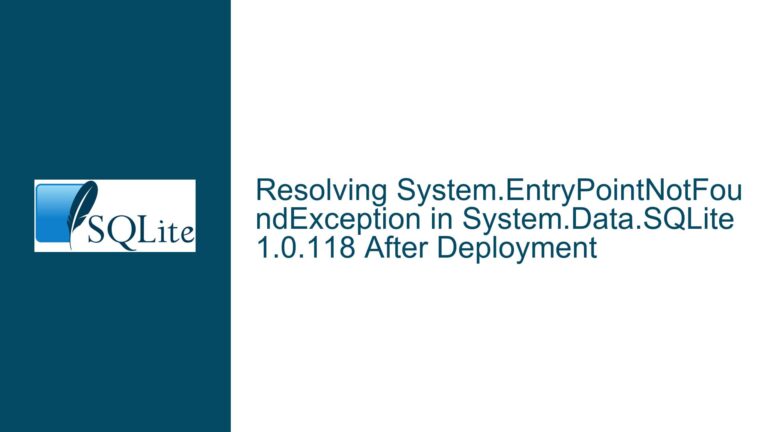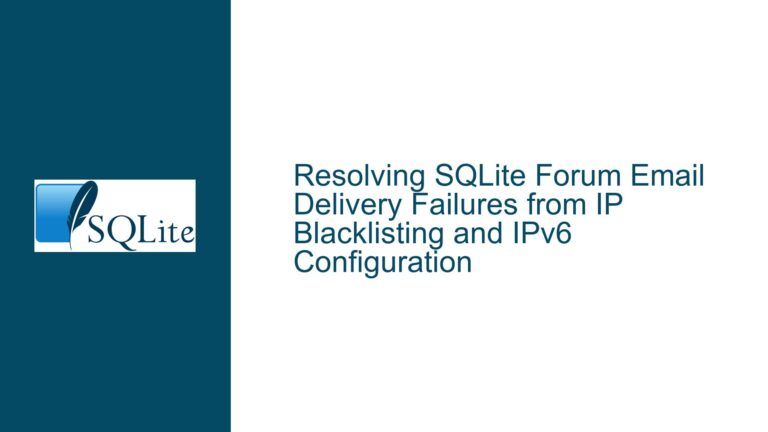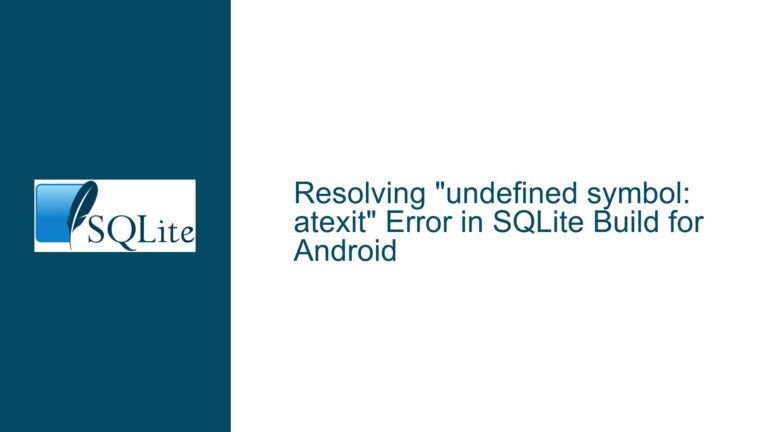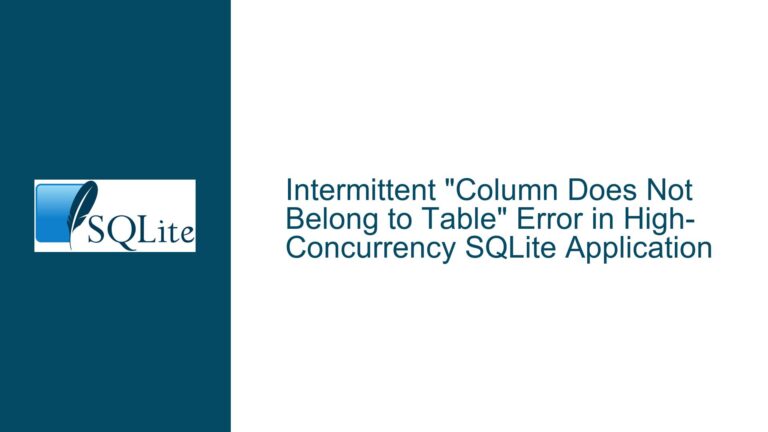and Resolving VACUUM INTO’s fsync Behavior in SQLite
Issue Overview: VACUUM INTO’s Lack of fsync and Its Implications
The VACUUM INTO command in SQLite is a powerful tool for creating a compacted and optimized copy of a database into a new file. However, the documentation for VACUUM INTO explicitly states that SQLite does not invoke fsync() or FlushFileBuffers() on the generated database file to ensure that the data has been written to non-volatile storage before the command completes. This behavior raises significant concerns about data integrity, especially in scenarios where the database is being copied to a new file for backup or migration purposes.
The fsync() system call (or FlushFileBuffers() on Windows) is critical for ensuring that all data buffered in memory is written to the physical storage device. Without this guarantee, there is a risk that data could be lost if a system crash or power failure occurs before the operating system has flushed its buffers to disk. This is particularly problematic for VACUUM INTO, as the command is often used in scenarios where data integrity is paramount, such as creating backups or migrating databases to new systems.
The core issue here is that VACUUM INTO does not enforce synchronization to disk, which could lead to data loss in the event of a system failure. This behavior is in contrast to other SQLite operations, where synchronization can be controlled using the PRAGMA synchronous setting. The lack of synchronization in VACUUM INTO is a deliberate design choice, likely made for performance reasons, but it introduces a potential risk that must be addressed by developers using this command.
Possible Causes: Why VACUUM INTO Omits fsync
The omission of fsync() or FlushFileBuffers() in the VACUUM INTO command can be attributed to several factors. First, the command was introduced in SQLite version 3.27, and its implementation was likely optimized for performance. By skipping the synchronization step, SQLite can complete the VACUUM INTO operation more quickly, as writing to disk is one of the slowest operations in database management.
Second, the VACUUM INTO command is designed to create a new database file, and the assumption may have been that the user would handle synchronization if needed. This approach aligns with SQLite’s philosophy of giving developers control over performance and safety trade-offs. However, this design choice places the burden of ensuring data integrity on the developer, which may not always be ideal, especially for those who are unaware of the implications.
Third, the temporary database used during the VACUUM operation typically has synchronization disabled for performance reasons. This behavior was carried over to VACUUM INTO without considering that the output of VACUUM INTO is a permanent database file, not a temporary one. As a result, the same performance optimizations were applied, leading to the omission of fsync() or FlushFileBuffers().
Finally, the documentation for VACUUM INTO explicitly states that synchronization is not performed, which suggests that this behavior was intentional. However, the documentation does not provide guidance on how to ensure data integrity when using this command, leaving developers to figure out the best approach on their own.
Troubleshooting Steps, Solutions & Fixes: Ensuring Data Integrity with VACUUM INTO
To address the issue of data integrity when using VACUUM INTO, several steps can be taken. These include modifying the SQLite source code to enable synchronization, using external tools to enforce synchronization, and updating the documentation to provide clearer guidance.
Modifying the SQLite Source Code
One approach is to modify the SQLite source code to enable synchronization for the output database file created by VACUUM INTO. This can be done by setting the PAGER_SYNCHRONOUS_NORMAL flag for the temporary database used during the VACUUM INTO operation. The following patch demonstrates how this can be achieved:
Index: src/vacuum.c
==================================================================
--- src/vacuum.c
+++ src/vacuum.c
@@ -353,12 +353,15 @@
if( NEVER(rc!=SQLITE_OK) ) goto end_of_vacuum;
}
if( pOut==0 ){
rc = sqlite3BtreeCopyFile(pMain, pTemp);
+ if( rc!=SQLITE_OK ) goto end_of_vacuum;
+ } else {
+ sqlite3BtreeSetPagerFlags(
+ pTemp, PAGER_SYNCHRONOUS_NORMAL | PAGER_CACHESPILL);
}
- if( rc!=SQLITE_OK ) goto end_of_vacuum;
rc = sqlite3BtreeCommit(pTemp);
if( rc!=SQLITE_OK ) goto end_of_vacuum;
#ifndef SQLITE_OMIT_AUTOVACUUM
if( pOut==0 ){
sqlite3BtreeSetAutoVacuum(pMain, sqlite3BtreeGetAutoVacuum(pTemp));
This patch ensures that synchronization is enabled for the output database file, providing a guarantee that the data has been written to non-volatile storage before the command completes. This change addresses the core issue by ensuring that fsync() or FlushFileBuffers() is called as part of the VACUUM INTO operation.
Using External Tools to Enforce Synchronization
If modifying the SQLite source code is not an option, developers can use external tools to enforce synchronization after the VACUUM INTO operation completes. On POSIX systems, this can be done by opening the output database file and calling fsync() on the file descriptor. On Windows, the FlushFileBuffers() function can be used to achieve the same result.
Here is an example of how this can be done on a POSIX system:
#include <fcntl.h>
#include <unistd.h>
int fd = open("other.db", O_RDWR);
if (fd == -1) {
// Handle error
}
if (fsync(fd) == -1) {
// Handle error
}
close(fd);
And here is an example for Windows:
#include <windows.h>
HANDLE hFile = CreateFileW(L"other.db", GENERIC_WRITE, 0, NULL, OPEN_EXISTING, FILE_ATTRIBUTE_NORMAL, NULL);
if (hFile == INVALID_HANDLE_VALUE) {
// Handle error
}
if (!FlushFileBuffers(hFile)) {
// Handle error
}
CloseHandle(hFile);
These examples demonstrate how to ensure that the data written by VACUUM INTO is safely stored on disk. However, this approach requires additional code and may not be as convenient as having synchronization handled directly by SQLite.
Updating the Documentation
Finally, the SQLite documentation for VACUUM INTO should be updated to reflect the changes made to ensure synchronization. The current documentation states that fsync() or FlushFileBuffers() is not called, which is no longer accurate if the source code has been modified to enable synchronization. The documentation should also provide guidance on how to ensure data integrity when using VACUUM INTO, including the use of external tools if necessary.
Here is an example of how the documentation could be updated:
The
VACUUM INTOcommand creates a compacted and optimized copy of the database in a new file. By default, SQLite ensures that the data is written to non-volatile storage before the command completes by callingfsync()orFlushFileBuffers()on the generated database file. If you need to disable synchronization for performance reasons, you can modify the SQLite source code or use external tools to enforce synchronization after the command completes.
This updated documentation provides a clearer explanation of the behavior of VACUUM INTO and offers guidance on how to ensure data integrity.
Conclusion
The issue of VACUUM INTO not invoking fsync() or FlushFileBuffers() is a significant concern for developers who rely on this command for creating backups or migrating databases. By understanding the reasons behind this behavior and exploring potential solutions, developers can ensure that their data remains safe and consistent. Whether through modifying the SQLite source code, using external tools, or updating the documentation, there are several ways to address this issue and improve the reliability of VACUUM INTO.






